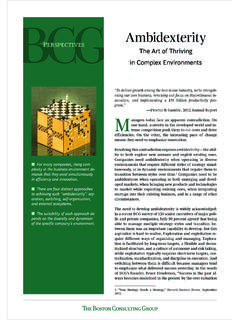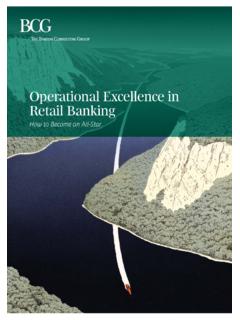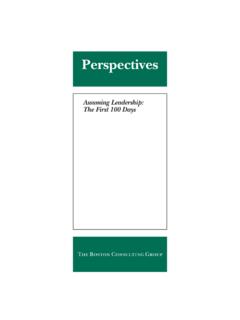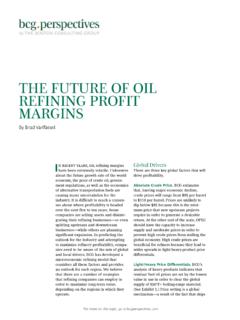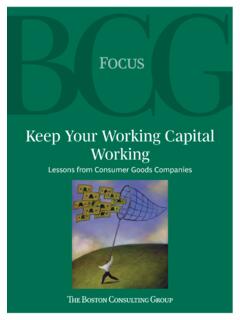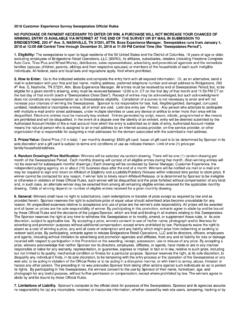Transcription of Retail Banking: Winning Strategies and Business …
1 Retail BankingWinning Strategies and Business Models RevisitedReinhold Leichtfuss, Reinhard Messenb ck, Vincent Chin, Matthew Rogozinski, Steven Thogmartin, and Andr XavierJanuary 2010 The Boston Consulting Group January 2010A Stabilizing Force 1A Sizable, Resilient Business 1 Stable but Not Immune 2 Familiar and New Challenges 2 Performance by Region 4 The Americas 6 Europe 6 The Middle East 7 Asia 7 Australia 7 Winning Banks and Business Models 7 Taking Action 10 Upgrade Credit Policies and Risk Management Skills 10 Solve the Growth Problem 11 Embed Cost Efficiency in Processes and Platforms 12 Prioritize Performance Capabilities 12 ContentsThe Boston Consulting Group January 2010 Throughout more than two years of financial crisis and economic turmoil, the Retail Business has proved to be an irreplaceable source of stability for most banks.
2 What this sector lacks in explosive performance it makes up for by providing a cushion against sharp downturns. But like all other parts of the financial services industry, it has been strained by the turmoil. As a result, most Retail banks have taken steps to reinforce their fundamentals by cutting costs and reaching out to important as it has been for banks to respond to the immediate challenges posed by the crisis, it has become just as important to take a strategic view of how the industry is changing. Retail banks were buffeted by challenges before the crisis as described in our last major report on this sector and now they are dealing with a shifting The changes range from short-term to semipermanent, depending on the market. Together, they will have a major impact on profitability and growth over the next few years.
3 This paper aims to help banks reassess their Strategies , Business models, and plans for emerging from the crisis faster and in a stronger position than their peers. It includes insights into the performance of Retail banks from 2001 through 2008 and in the first three quarters of 2009, based on data from more than 140 banks around the globe. (For more on our approach, see the sidebar The BCG Retail banking Database. ) Specifically, we explore the following issues:The inherent strengths of the Retail banking sector, as well as the challenges it is facing owing to both the crisis and several trends that predated the performance of Retail banks in five major regions: the Americas, Europe, the Middle East, Asia, and Australia. Each of these regions has been affected differently by the crisis, and even within regions, banking performance has varied different Business models have fared over the long term as well as during the crisis.
4 The drivers of performance vary among the models, but our analysis identified a set of levers essential to ensuring growth and profitability for all Retail banks, regardless of type. A Stabilizing ForceIn the wake of the crisis, banks have come to rely on their Retail operations as an invaluable source of funding for the asset side of the balance sheet. Some banks have also developed a greater appreciation for the Retail Business in particular, for its sheer size and relative stability, both of which can help steady performance in times of crisis. A Sizable, Resilient Business With group profits and revenues decreasing because of the credit crunch, the Retail Business has assumed a bigger share of total banking revenues. In 2008, Retail banking activities accounted for 55 percent of the revenues generated by the 140 banks in our database, up from 45 percent in 2006.
5 Retail banking revenues actually continued to increase in the first half of 2008 but have since fallen, driven by the flight to safety triggered by the crisis. Stung by losses and shocked by high-profile financial scandals, investors have shifted their liquidity and savings toward products they perceive to be safer, such Retail BankingWinning Strategies and Business Models Revisited1. See Retail banking : Facing the Future, BCG report, November Boston Consulting Group January 2010 Retail banking 2as deposits. The subsequent competition for deposits has put pressure on margins. Higher savings rates have increased the flow of new funds, which has only partially offset the effects of lower margins. In addition, consumers have shifted some of their money to Retail banks considered to be stable and reliable, either because of government guarantees or because these institutions are not associ-ated with highly complex, risky activities.
6 This trend has led to gains for some banks and losses for others. Still, with their revenues holding up relatively well, Retail banks in 2008 posted better cost-to-income ratios (CIRs) than did banking groups. (CIR is the core measure of efficiency for banks: it compares operating costs with revenues.) In Europe, the average CIR of Retail banks was 14 percentage points lower than the group ratio. This disparity was due, in large part, to the decline in group revenues, especially in invest-ment banks also outperformed banking groups in return on assets (ROA) in 2008, as they did across all regions before the In most places, this performance gap widened as group performance fell more steeply than Retail performance. In the Americas, for example, the average Retail - banking ROA was 162 percent higher than the average group ROA in 2008.
7 From 2001 through 2006, it was 51 percent higher. (See Exhibit 1.)Stable but Not Immune Retail -focused banks are less likely than more diversified banks to experience wild swings in performance. As resilient as they have been, however, Retail banks were far from insulated from the crisis. In fact, banks have lost some or all of the gains in efficiency and productivity made during the precrisis boom. The average Retail - banking CIR improved by seven percentage points from 2001 through 2006, falling to 55 percent. But from 2006 through 2008, the ratio increased by three percentage points. Likewise, the average ROA improved from percent in 2001 to percent in 2006. From 2006 through 2008, it fell by nearly half, to performance can be seen as a symptom of the global economic downturn, but Retail banks also made their share of bad decisions and miscalculations in the run-up to the crisis.
8 Their exposure to unsustainable levels of consumer and small- Business debt led to a sharp rise in loan loss provisions, along with a string of bank failures. Familiar and New ChallengesBCG s 2007 report on Retail banking outlined two major challenges stemming from long-term trends: intensifying competition and increasing pressure on before the crisis sent banks scrambling for deposits, the Retail banking sector was growing more competitive. The reasons included the deregulation and opening of international markets, the ongoing regional expansion and globalization of many banks, the expansion of direct and online banking , and 2. Because only a limited number of the banks in our database reported accurate equity ratios (which are used to calculate return on equity and return on risk-adjusted capital) for their Retail divisions, we used the more widely available measure of ROA to gauge BCG Retail banking Database comprises Retail and group data for more than 140 banks worldwide.
9 These banks represented 55 percent of global Retail - banking revenues in 2008. The Retail banking data are as stated by the individual banks for their Retail - banking divisions. The definition of Retail banking activities and the application of accounting standards vary among banks. To ensure comparability, we adjusted the data for mergers and divestments and scrutinized data that were above normal thresholds. The BCG Retail banking DatabaseThe Boston Consulting Group January 2010 Retail banking 3rising customer expectations. To some extent, the financial crisis has lessened the competitive intensity in Retail banking , but only temporarily. Banks that are struggling with equity losses have been forced to trim their balance sheets and, as a result, are curtailing international activities.
10 The sale of overseas Retail - banking units, often to local incumbents, will reduce competitive pressure in the short term (especially since these units often have an attacker mindset). But new attackers, some of which emerged as winners during the crisis, are going on the trends that led to greater competition before the crisis such as the rise of online banking have persisted. In a recent survey by the American Bankers Association, 25 percent of customers named Internet banking as their preferred channel, compared with 21 percent for branch banking and 17 percent for ATMs. This trend is not confined to developed markets. In China, Ping An Insurance launched an online account-aggregation and financial-management tool that provides access to other service providers, including banks, insurers, travel agents, and social-media pressure was evident before the onset of the crisis.
